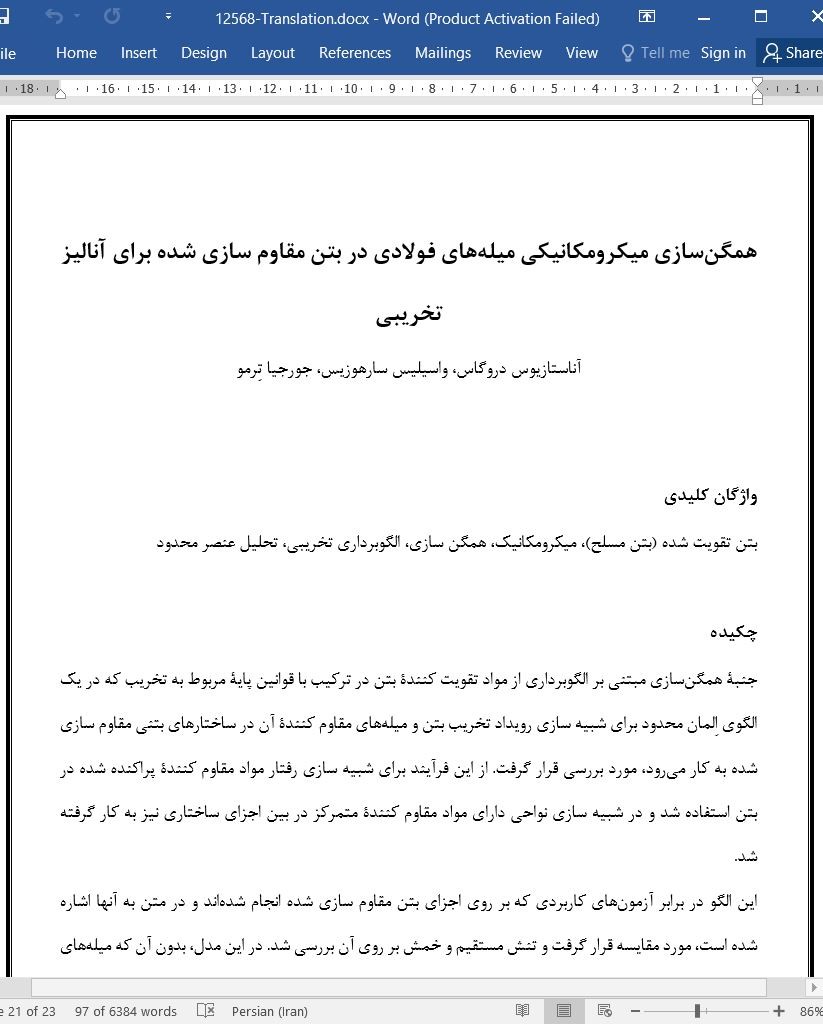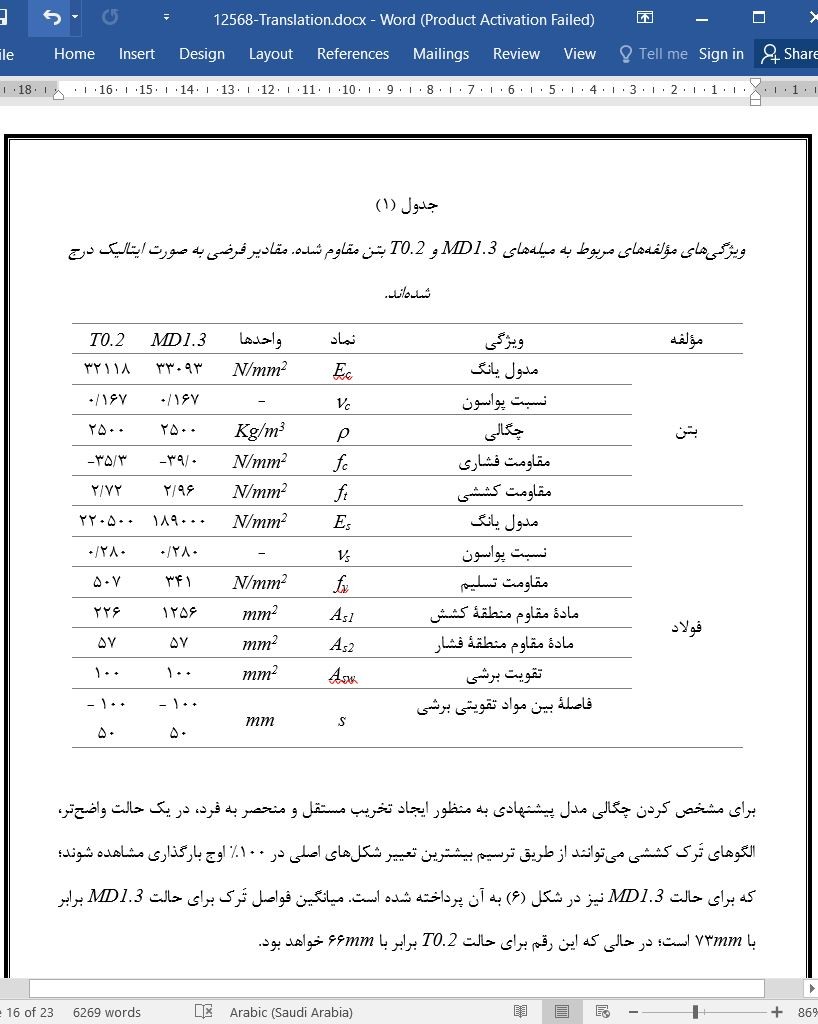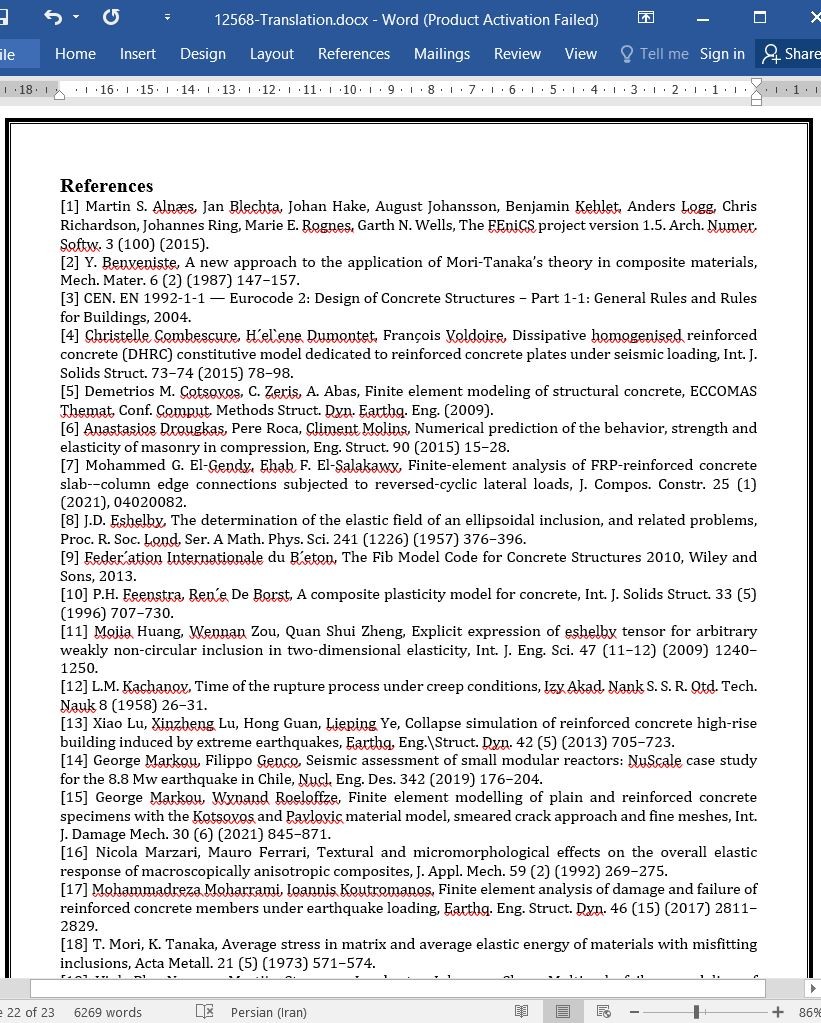
همگنسازی میکرومکانیکی میلههای فولادی در بتن مقاوم سازی شده برای آنالیز تخریبی
چکیده
جنبۀ همگنسازی مبتنی بر الگوبرداری از مواد تقویت کنندۀ بتن در ترکیب با قوانین پایۀ مربوط به تخریب که در یک الگوی اِلمان محدود برای شبیه سازی رویداد تخریب بتن و میلههای مقاوم کنندۀ آن در ساختارهای بتنی مقاوم سازی شده به کار میرود، مورد بررسی قرار گرفت. از این فرآیند برای شبیه سازی رفتار مواد مقاوم کنندۀ پراکنده شده در بتن استفاده شد و در شبیه سازی نواحی دارای مواد مقاوم کنندۀ متمرکز در بین اجزای ساختاری نیز به کار گرفته شد.
این الگو در برابر آزمونهای کاربردی که بر روی اجزای بتن مقاوم سازی شده انجام شدهاند و در متن به آنها اشاره شده است، مورد مقایسه قرار گرفت و تنش مستقیم و خمش بر روی آن بررسی شد. در این مدل، بدون آن که میلههای جایگذاری شده به صورت شبکهای درآیند و هزینههای محاسباتی بالایی متحمل شود، ویژگیهای اصلی عملکرد تخریبی در مواد جایگزین شونده در بتن مورد ارزیابی قرار گرفتهاند.
1.مقدمه
الگوبرداری آغاز تخریب و نحوۀ انتشار آن در ساختار بتن مقاوم سازی شده برای پیش بینی رفتار آتی آن در مقابل تنشهای گوناگون، از اهمیت زیادی برخوردار است. تَرکهای ایجاد شده به وسیلۀ بارهای مکانیکی، قرار گرفتن میلههای مقاوم سازی در معرض تأثیرات زیست محیطی و حملات شیمیایی، هر یک میتواند ماندگاری و دورۀ خدماترسانی بتن را به طور چشمگیری کاهش دهد [26]. علاوه بر این، سناریوهای تحمیل بار بیش از حد که منجر به ایجاد تَرک در بتن میشوند، میتوانند استحکام و سختی بتنهای مقاوم سازی شدهای که در آینده به وفور مورد تقاضا قرار خواهند گرفت، مثل بتنهای مقاوم در برابر زمین لرزههای شدید را کاهش دهد [27].
7. دستاوردها
جنبۀ همگنسازی سازههای بتنی مقاوم شده بر اساس ویژگیهای میکرومکانیکی مواد تقویت کننده، ضمن ترکیب با فرآیند الگوبرداری پایۀ شکست مصالح بر اساس شرایط مکانیکی تخریب، به وسیلۀ یک آنالیز غیر خطی محدود، مورد اجرا و ارزیابی قرار گرفت. این روش پیشنهادی میتواند ویژگیهای برجستۀ بتن و میلههای تقویت کنندۀ آن را بدون آن که تغییری در شبکه بندی میلههای قرار گرفته در بتن ایجاد کند، مورد بررسی قرار دهد. همچنین این الگو قادر است تا گنجایش میلههای مقاوم کنندۀ بتن را با دقت بالا، هزینۀ محاسباتی کم، و هزینۀ الگوبرداری هندسی پایین برآورد کند.
Abstract
A homogenisation scheme based on inclusion modelling is coupled with constitutive laws for damage and implemented in a finite element model for the simulation of concrete and reinforcement bar damage in reinforced concrete structures. The scheme is employed for simulating the behaviour of evenly distributed reinforcement and adapted for the simulation of zones with concentrated reinforcement in structural members.
The model is validated against experimental tests from the literature carried out on reinforced concrete members subjected to bending and direct tension. The model captures the main characteristics of the behaviour of and damage in the constituent materials of reinforced concrete without resorting to individual meshing of the embedded bars and with very low computational cost.
1. Introduction
Modelling the damage initiation and propagation in reinforced concrete structures is critical for predicting their behaviour against a variety of actions. Cracks caused by mechanical loading, exposing the reinforcement bars to environmental effects and chemical attack, can significantly reduce durability and service life [26]. Additionally, excessive loading scenarios leading to cracking of the concrete can lead to a reduction of residual stiffness and strength in reinforced concrete members against future high demands, such as those arising during earthquake events [27].
7. Conclusions
A homogenisation scheme for reinforced concrete structures based on inclusion micromechanics, combined with constitutive modelling of material failure based on damage mechanics, is developed and implemented in a finite context for nonlinear analysis. The proposed scheme is able to capture the salient characteristics of the behaviour of concrete and reinforcement bars in reinforced concrete without resorting to distinct meshing of the reinforcement bars embedded in the concrete. The model is able to predict the capacity of reinforced concrete beams with good accuracy, low computational cost and low geometrical modelling effort.
چکیده
1.مقدمه
2. مدل میکرومکانیکی
3. الگوبرداری ساختاری
4. اجرای تحلیل اِلمان محدود
5. تأیید و اعتباربخشی مدل
5-1 خمش میلههای بتن مسلح
6. میلههای بتن مقاومسازی شده در وضعیت تنش
7. دستاوردها
منابع
ABSTRACT
1. Introduction
2. Micromechanical model
3. Constitutive modelling
4. Finite element implementation
5. Model validation
5.1. Reinforced concrete beams in bending
6. Reinforced concrete beams in tension
7. Conclusions
References
- ترجمه فارسی مقاله با فرمت ورد (word) با قابلیت ویرایش، بدون آرم سایت ای ترجمه
- ترجمه فارسی مقاله با فرمت pdf، بدون آرم سایت ای ترجمه



